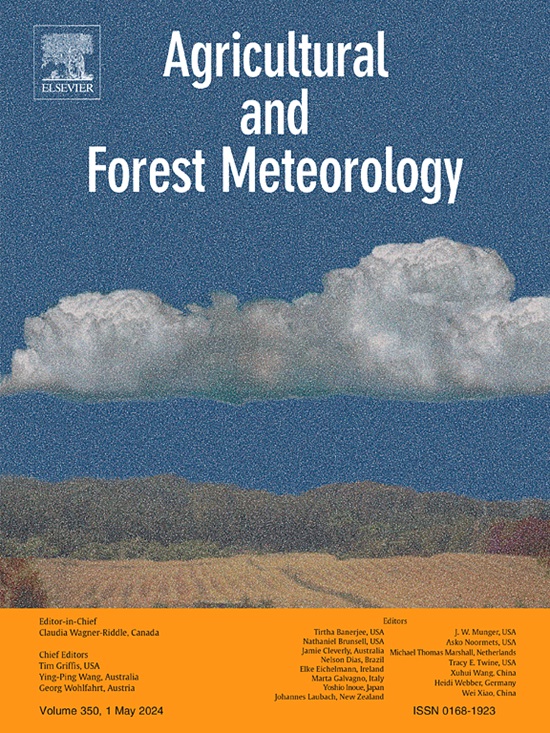在青藏高原东北部,立地干旱性对夜间树液流的影响比气孔行为不同的树种更大
IF 5.7
1区 农林科学
Q1 AGRONOMY
引用次数: 0
摘要
气候变化增加了干旱发生的频率和强度,改变了区域干旱程度。以往的研究主要集中在季节性干旱对夜间液流的暂时影响上,但长期的站点干旱水平和物种特异性气孔行为如何影响夜间液流尚不清楚。在青藏高原东北部4个干旱半干旱区,对16棵等水青海云杉(Picea crassifolia)北坡树种和14棵各水祁连杜松(Juniperus przewalskii)南坡树种的树液通量密度及其相关环境因子进行了监测。我们评估了它们在2019年生长季节(5月至9月)的夜间液流密度(Fn)、夜间液流量(Qn)和Qn与每日液流量(Qn/Q)的比例。结果表明,干旱区非阴雨日Qn约占全天总Qn的83%,半干旱区约占78%。干旱区祁连杜松和青海云杉在非阴雨天的平均Qn/Q分别为8%和5%,而半干旱区则分别为15%和14%。Fn和Qn/Q在干旱程度(2 ~ 4倍)之间的差异比种间(<;1.3倍)。在半干旱区,大气水汽压差对两种树种的Fn都起主导作用(杉木和云杉的r分别为0.86和0.78),而土壤水势对干旱区两种树种Fn的影响更为显著(杉木和云杉的r分别为0.26和0.57)。我们的研究结果表明,在高海拔旱地生态系统中,立地干旱程度对夜间树液流及其环境响应的影响比物种特有的气孔行为更大。本文章由计算机程序翻译,如有差异,请以英文原文为准。
Site aridity has a stronger impact on nocturnal sap flow than species with contrasting stomatal behaviors on the northeastern Tibetan Plateau
Climate change is increasing the frequency and intensity of drought episodes, altering regional aridity levels. Previous studies have focused on the temporary impacts of seasonal drought on nocturnal sap flow, but how long-term site aridity levels and species-specific stomatal behaviors influence nocturnal sap flow remains unclear. Here, we monitored sap flux density and relevant environmental factors for 16 isohydric Qinghai spruce (Picea crassifolia) trees on the north-facing slope and 14 anisohydric Qilian juniper (Juniperus przewalskii) trees on the south-facing slope at four arid to semi-arid sites on the northeastern Tibetan Plateau. We assessed their nocturnal sap flux density (Fn), nocturnal sap flow volume (Qn), and the proportion of Qn to daily sap flow volume (Qn/Q) over the growing season (May through September) in 2019. Our results show that Qn on non-rainy days accounted for about 83 % of total Qn on all days in the arid region and about 78 % in the semi-arid region. The average Qn/Q on the non-rainy days was 8 % for Qilian juniper and 5 % for Qinghai spruce at the arid sites, while it was 15 % and 14 %, respectively, at the semi-arid sites. Differences in Fn and Qn/Q were more pronounced between aridity levels (2–4 times) than between species (< 1.3 times). In the semi-arid region, atmospheric vapor pressure deficit dominated Fn for both species (r = 0.86 for juniper and 0.78 for spruce), while soil water potential had a more significant impact on Fn in the arid region (r = 0.26 for juniper and 0.57 for spruce). Our findings suggest that site aridity levels have a stronger impact on nocturnal sap flow and its environmental response than species-specific stomatal behaviors in high-elevation dryland ecosystems.
求助全文
通过发布文献求助,成功后即可免费获取论文全文。
去求助
来源期刊
CiteScore
10.30
自引率
9.70%
发文量
415
审稿时长
69 days
期刊介绍:
Agricultural and Forest Meteorology is an international journal for the publication of original articles and reviews on the inter-relationship between meteorology, agriculture, forestry, and natural ecosystems. Emphasis is on basic and applied scientific research relevant to practical problems in the field of plant and soil sciences, ecology and biogeochemistry as affected by weather as well as climate variability and change. Theoretical models should be tested against experimental data. Articles must appeal to an international audience. Special issues devoted to single topics are also published.
Typical topics include canopy micrometeorology (e.g. canopy radiation transfer, turbulence near the ground, evapotranspiration, energy balance, fluxes of trace gases), micrometeorological instrumentation (e.g., sensors for trace gases, flux measurement instruments, radiation measurement techniques), aerobiology (e.g. the dispersion of pollen, spores, insects and pesticides), biometeorology (e.g. the effect of weather and climate on plant distribution, crop yield, water-use efficiency, and plant phenology), forest-fire/weather interactions, and feedbacks from vegetation to weather and the climate system.

 求助内容:
求助内容: 应助结果提醒方式:
应助结果提醒方式:


